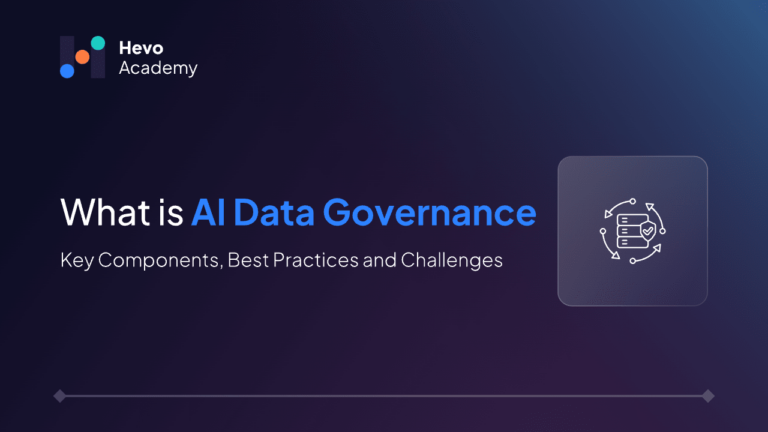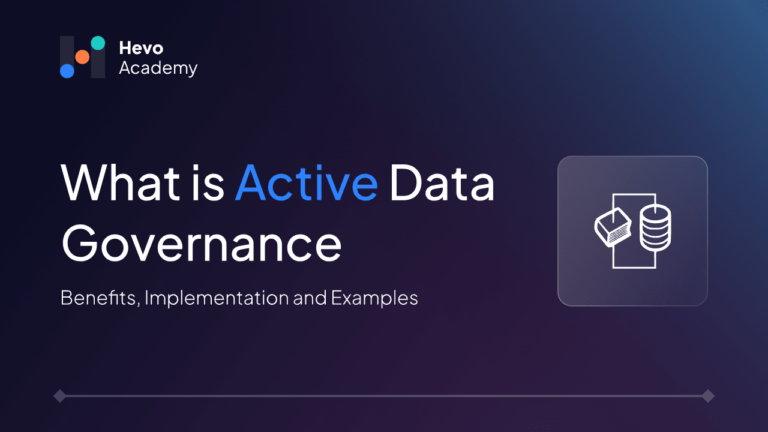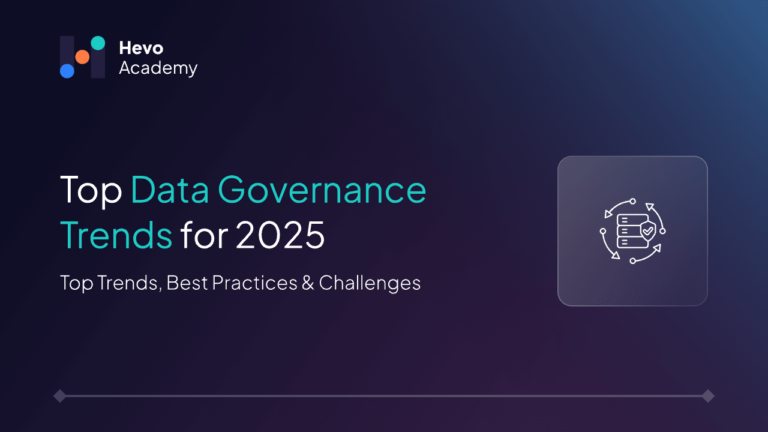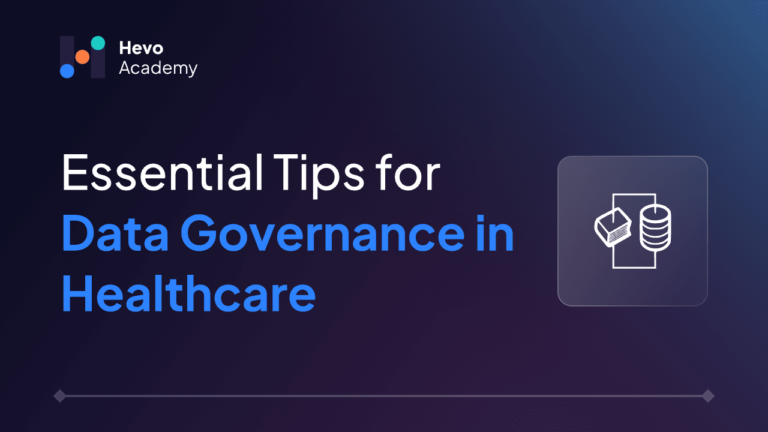Hey there!
Table of Contents
AI technology operates quickly to transform operations in sectors, including healthcare, finance, and retail industry operations. The processing of enormous amounts of data allows AI to deliver quick and more intelligent decisions. Data quantity increases the level of obligations that organizations must handle. AI systems make decisions by analyzing either flawed data or biased information. Scary, right? Implementing AI data governance systems provides important solutions to control AI-enhanced operations. This blog covers every essential detail regarding AI data governance, from its importance to successful implementation.
Let’s dive in!
What is Data Governance?
Alright, let’s start with the basics.
Data governance is an organized system for data grouping that produces successful data organization. Data governance creates an organizational framework that protects accurate and secure data accessibility for everyone. Every employee, including business analysts and IT staff, must understand their responsibilities through fundamental data management procedures established by data governance.
Why does it matter? Well, here are a few reasons:
- Data Integrity: Have you ever encountered outdated and contradictory data? This situation is undoubtedly frustrating. Frustrating, right? Good governance maintains data accuracy and reliability.
- Compliance: The regulations, including GDPR and CCPA, establish specific rules regarding data management by organizations. The legal systems require governance to determine compliance with regulations.
- Security: The increasing number of cyber threats makes protecting important information an obvious requirement.
In short, data governance turns data from a potential liability into a powerful asset. To know more about data governance, read about data governance principles in our detailed blog.
What is AI Data Governance?
Now, let’s level up to AI data governance.
The purpose of data organization goes beyond simple storage because it is vital for your business needs. A governance system needs customization to adapt to AI system requirements. Why? Data management with AI systems requires special consideration because the technology operates based on information learning. The learning methods of AI boost the need for efficient data management because AI obtains its information through processing data.
How It Differs From Traditional Data Governance?
So, what sets AI data governance apart? While traditional governance focuses on managing data quality and compliance, AI data governance digs deeper. For example:
- Bias Detection: AI systems naturally acquire biases from inequities in their training datasets. Governance measures and solutions are implemented to locate and resolve discriminatory biases.
- Ethics: AI systems implement decisive operations that impact actual persons through automation. Ethical considerations become key.
- Continuous Monitoring: AI models evolve over time, so their performance needs regular check-ups to stay accurate and fair.
Key Principles of AI Data Governance
- Transparency: Always know where your data comes from and how your AI uses it.
- Accountability: Ensure someone is responsible for your AI’s actions and outcomes.
- Fairness: Avoid reinforcing societal biases or discrimination through AI.
- Data Privacy: Respect people’s privacy and follow data protection laws.
Why AI Data Governance Matters?
The reason behind this important matter warrants discussion. An AI system is a loan approval mechanism and medical diagnostic instrument. When biased or flawed data supplies an AI system, the results may cause serious harm to individuals and your organization. Organizations must implement AI data governance for the following reasons:
- Building Trust: Users expect your AI solutions to function fairly and perform accurately. Governance helps prove that.
- Staying Compliant: The regulatory landscape tightened its rules regarding AI implementations. Your compliance remains intact when you practice good governance, which also prevents steep financial penalties from occurring.
- Reducing Risks: Data governance challenges and failures create three main problems: inaccurate predictions, reputation harm, and legal actions.
- Boosting AI Performance: AI performance improvements result directly from data quality that leads to satisfactory outcomes. It’s as simple as that.
Key Components of AI Data Governance

How do you govern AI data? Here are the building blocks:
1. Data Quality Management
The operation of AI models heavily depends on high-quality input data. Inaccurate predictions and biased results appear when using poor-quality data. Effective data quality management includes:
- Data Cleaning: Data cleaning eliminates duplicate records while fixing errors and dealing with unregistered data points.
- Data Standardization: The consistency of datasets should be maintained through standardization procedures regarding units and formats, along with field labels.
- Data Validation: Organizations should enable automated quality control systems that check data to ensure accuracy, completeness, and reliability.
- Data Lineage Tracking: A system must track the complete path data takes from its origin through transformation and its ultimate usage throughout time.
2. Bias Detection and Mitigation
The presence of bias in AI systems creates problems that include unethical outcomes, discrimination, and issues affecting ethical standards. Organizations need to actively search for bias in their systems, which requires the following measures:
- Dataset Diversity Checks: An organization should conduct dataset diversity checks to ensure training information includes data from various demographic groups in different geographic regions, representing multiple contexts.
- Bias Audits: Fairness metrics serve as tools to find discrimination patterns during bias audits.
- Algorithmic Adjustments: System developers should add specific fairness constraints during development to stop decision-making discrimination.
- Human-in-the-Loop Oversight: AI insights gain added value through human judgment within oversight systems, which help detect and eliminate potential bias.
3. Model Accountability
AI systems need to maintain transparency and responsibility when producing decisions. This involves:
- Documenting AI Workflows: Recording all AI workflow elements starts with documenting training data while adding algorithm protocols and testing method records.
- Explainable AI (XAI): XAI protocols enable developers to generate systems that reveal their prediction logic to human users.
- Human Oversight: Human Oversight includes assigning teams and individuals who must evaluate and confirm AI output decisions.
- Error Logging & Correction Mechanisms: Organizations need to create systems that monitor and solve errors that appear in operation.
4. Ethical Guidelines
AI implementation needs ethical principles to protect from harm and guarantee fairness. Ethical governance includes:
- Fairness and Non-Discrimination: The deployment of AI systems requires systems to maintain complete impartiality when treating different groups.
- Transparency in AI Decisions: Users need to understand through transparency the methods AI uses to generate its decisions.
- User Consent and Control: User Consent and Control functions when people can choose whether AI drives their choices.
- Corporate Social Responsibility (CSR): Organizations must evaluate the complete social effects of Artificial Intelligence to demonstrate Corporate Social Responsibility (CSR).
5. Regulatory Compliance
Computer systems under AI must respect legal requirements and all relevant industry standards. The following criteria must be fulfilled through governance to achieve compliance:
- GDPR (General Data Protection Regulation): Governs European data privacy and security.
- CCPA (California Consumer Privacy Act): The California Consumer Privacy Act (CCPA) protects California citizens’ personal data rights.
- EU AI Act: Regulates high-risk AI applications for fairness and transparency.
- Industry-Specific Regulations: Each sector maintains its regulations for artificial intelligence systems to comply with, among the finance and healthcare sectors.
6. Security and Privacy Controls
AI data governance systems must secure sensitive data from potential cyber incidents and breaches. Security measures include:
- Data Encryption: Data Encryption ensures both the protection of stored data and information security during transmission.
- Access Control Mechanisms: AI data usage receives restriction through access control mechanisms that apply user-based permission systems.
- Anonymization & Data Masking: Data anonymization, along with data masking techniques, functions to hide personal information to stop its improper usage.
- Incident Response Plans: Predefined plans for data breaches could be found in incident response plans, enabling organizations to prepare for incidents.
7. Continuous Monitoring and Auditing
AI systems develop automatically over time, yet they must be assessed regularly to keep their performance metrics stable and equitable. The following aspects need to be present in governance frameworks:
- Model Drift Detection: Discovering how data pattern changes cause performance impacts on AI systems is known as Model Drift Detection.
- Regular Performance Audits: The assessment of AI predictions against their predicted objectives should happen through routine performance audits.
- Feedback Loops: A feedback loop allows users and stakeholders to submit AI problems, leading to constant improvement.
- Automated Monitoring Systems: Using AI-based tracking tools supports automated monitoring systems for identifying anomalies alongside compliance issues.
8. Centralized Data Management
A single data management system that unites all components leads to better governance alongside improved data consistency. Key elements include:
- Data Catalogs: Maintaining an organized inventory of datasets and their metadata.
- Version Control: Version Control is a system that enables users to track changes made to information and model alterations that occur throughout time.
- Data Sharing Policies: The rules of data sharing operate to determine access rights, modification powers, and application privileges of AI data.
- Integration with Business Systems: Organization-wide data strategies receive compatibility through governance protocols that integrate with business system operations.
By implementing fundamental management components, organizations can deliver AI systems that yield beneficial results for business operations and society.
Challenges in AI Data Governance
Of course, it’s not all smooth sailing. Here are some hurdles organizations face:
1. Complexity of AI Models: The complicated nature of AI models leads people to use the expression black box AI. Unlike other AI systems, certain models make decisions without being able to explain their operations. Inadequate transparency has become a primary issue for organizations today.
2. Data Bias: The composition of your training data primarily contains samples from one particular demographic. Your computer program might create biased outcomes from its data. Fixing this isn’t always easy.
3. Evolving Regulations: The latest legislation, such as GDPR, marks the start of forthcoming changes in data regulations. Governments work to match their AI knowledge by introducing regular new rules. Keeping up can feel overwhelming.
4. Resource Intensive: Creating a strong governance structure requires significant resources, which need both time and specialized expertise, and monetary support. Small organizations might find establishing this system to be a significant challenge.
5. Stakeholder Alignment: Organization stakeholders tend to pursue divergent business priorities, as each unit operates independently of others. The challenge of achieving unanimous agreement regarding governance policies becomes complicated to overcome.
Best Practices for AI Data Governance

What are the methods to handle such difficulties? Here are some actionable tips:
1. Define Clear Roles and Responsibilities: You should establish precise roles and responsibilities by designating positions such as data stewards alongside AI ethics officers. Establishing clear accountability measures helps identify all important details to prevent major oversight problems.
2. Conduct Regular Audits: The operation of your AI systems should be supported through periodic audits, which function like medical examinations. These mechanisms detect and solve potential problems during their initial phases to prevent serious difficulties.
3. Invest in Explainable AI (XAI): Your AI systems should receive investments for Explainable AI (XAI) techniques, which create a better understanding of system decisions. The approval process creates reliability between people while facilitating easier system debugging.
4. Create a Centralized Data Repository: A dedicated data repository that serves as the sole authority ensures both simplicity of governance operations and keeps data aligned.
5. Foster a Culture of Ethics: Your organization’s ethical values must develop primarily through employees’ mental transformation. Develop staff competency in ethical AI techniques and activities promoting honest workplace dialogue.
6. Leverage AI Tools for Governance: AI tools provide support for governance through their ability to detect bias and monitor compliance. Take advantage of the available technology systems.
Conclusion
Implementing AI data governance systems leads to ethical results and reliable performance, producing superior outcomes in AI software systems. The sustainability of data governance enables ethical data generation by establishing trustworthy user systems.
Companies that establish governance frameworks at this time will gain future achievements throughout their business landscape. To create valuable systems from AI technology, developers should construct solutions that defend human dignity throughout their execution of service for humanity.
What do you think?
Has your team demonstrated enough preparedness to deal with AI data governance issues? To get consistent and accurate data for AI data governance, sign up for Hevo’s 14-day free triaL. With Hevo, centralize your data with ease.
FAQs
1. What is AI governance?
AI governance manages AI systems’ ethical, legal, and operational aspects to ensure they function responsibly and align with organizational goals.
2. Will AI replace data governance?
Not at all! AI can enhance data governance by automating tasks, but human oversight will always be crucial to ensure fairness and accountability.
3. How is AI used in governance?
AI helps automate processes, analyze large datasets, and detect anomalies, making governance more efficient and data-driven.
4. Who is leading AI governance?
Organizations like OpenAI and governments, including the EU, are responsible for developing AI governance frameworks. Check out the EU’s guidelines for more insights.





